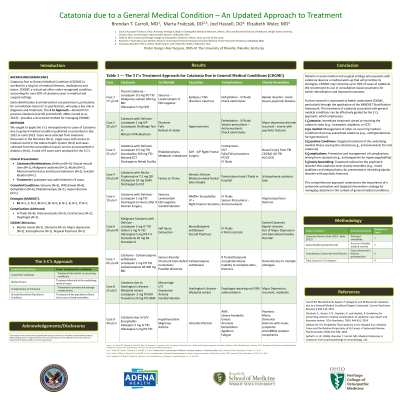Catatonia
(020) Catatonia due to a General Medical Condition – An Updated Approach to Treatment

.jpeg.jpg)
Brendan T. Carroll, MD (he/him/his)
Preceptor
Adena Health System
West Jefferson, Ohio- MF
Marta Fratczak, n/a
Medical student
OU-HCOM
Logan, Ohio - JH
Joel Hassell, DO
Psychiatry Resident
Adena Health System
Chillicothe, Ohio - EW
Elizabeth Wyler, MD
Resident Physician, PGY3
Adena Regional Health
Chillicothe, Ohio
Presenting Author(s)
Co-Author(s)
BACKROUND/SIGNIFICANCE
Catatonia due to general medical condition (CDGMC) is ascribed to a long list of medical illnesses, medications and toxins. CDGMC accounts for > 50% of patients with catatonia in medical and surgical settings. Thus, the consultation-liaison psychiatrist must be vigilant for this diagnosis and apply treatment for CDGMC. We propose the 5 Cs. This is derived from 2 earlier publications (Carroll and Goforth, 2004) and Carroll et al (2013). The 5 Cs are: 1) Treatment directed at catatonia, 2) Treatment directed at the co-morbid conditions, 3) Treatment directed at the causative condition, 4) Treatment to prevent the complications and 5) Treatment of the psychiatric illness that it most closely resembles.
METHODS
We sought to apply the 5 Cs retrospectively to cases of Catatonia due to general medical condition published or presented in late 2022 or early 2023. Cases were selected from extensive discussion in the literature (N=1), single cases with access to medical record in the Adena Health System (N=2) and cases collected from the consultation-liaison service and presented in didactics (N=6). A total of 9 cases were analyzed for the 5 C’s.
RESULTS
Five female patients and 4 male patients with an age range from 19 to 72 years. Catatonia presented with delirium (N=4), negativism (N=2), flaccid muscle tone (N=1), malignant (N=1) and abulia (N=1). Lorazepam was used in 8 cases. Comorbid conditions included: seizures (N=3), withdrawal (N=9), rhabdomyolysis (N=1) and dehydration (N=6). Causes as per MINDSET: M-1, I- 2, N-2, S-1, E-1 and T-2. Two were primarily psychiatric with hypernatremia (N=1) and seizures (N=1). Complications treated: IV fluids (N=6), anticonvulsants (N=3), contractures (N=1) and dysphagia (N=1). In these cases, patients closely resembled: bipolar mania (N=2), dementia (N=3), major depression (N=2), schizophrenia (N=1) and atypical psychosis (N=1).
CONCLUSION
Currently, clinicians are identifying cases of CDGMC. We feel 5 Cs approach may help to guide the treatment of catatonia due to a general medical condition. The approach to Catatonia due to a General Medical Condition is (in order of primacy of action);1. Catatonia -treat the catatonia (e.g. lorazepam or ECT), 2. Co-morbid - treat the other conditions that co-occur with catatonia (e.g. hypertension - antihypertensives), 3. Causative - treat the medical illness that is causing the catatonia (e.g. ictal catatonia - anticonvulsants), 4. Complications - treat or prevent the complications of catatonia (e.g. hypercoagulability - anticoagulants), and 5. Closely - treat the catatonia like the primary psychiatric disorder it most closely resembles (e.g. if it looks like bipolar disorder, mixed with psychotic features - mood stabilizers and antipsychotics)
Presentation Eligibility: Not previously published or presented.
Diversity, Equity, and Inclusion: Patients with catatonia may not always be recognized and treated.
Adena Health System serves a population in Appalachian Counties in Southeast Ohio.
Appalachian populations are historically marginalized.

